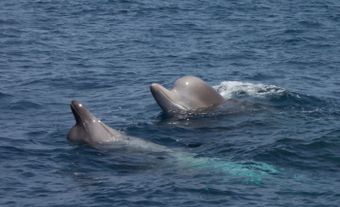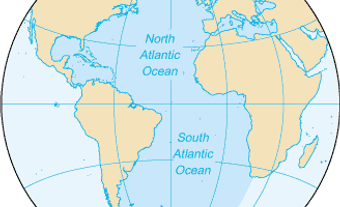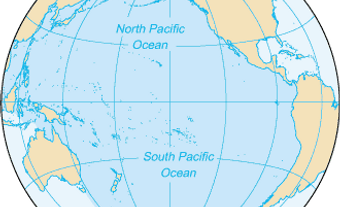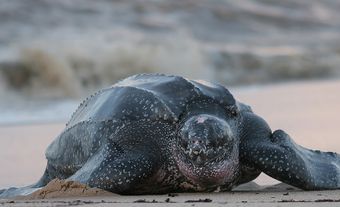The blue whale (Balaenoptera musculus) is the largest animal known to have ever lived on Earth. It is a difficult whale to study because of its low numbers and its preference for deep, offshore waters. Within Balaenoptera musculus, authorities recognize between three and five subspecies. Blue whales live in oceans throughout the world, including off the Atlantic and Pacific coasts of Canada. Although blue whale sightings are rare, experts believe that about 250 mature individuals live off each coast.
Physical Description
Blue whales are light to blue grey, with light and dark patches on most of their bodies. Their dorsal fins are relatively small. They have broad heads, which look U-shaped from above and flattened from the side. At birth, a blue whale calf is already 6–7 m long and weighs 2–3 tonnes. Later, it will grow to be 23–30 m long — about the length of three school buses — and weigh 50–150 tonnes. Females tend to be slightly larger than males, and some subspecies are larger than others. For example, blue whales in the southern hemisphere — especially the Antarctic — are usually larger than their northern cousins. When a blue whale is resting, it tends to sink because its body has negative buoyancy. This makes it easier to dive and also means that a blue whale sinks to the ocean floor when it dies.
Geographic Distribution and Habitat

Blue whales are found in oceans almost anywhere on Earth. When feeding, they can be seen in estuaries and shallow coastal areas. Otherwise, they usually stay far offshore. Some individuals migrate seasonally between higher and lower latitudes. Experts estimate that there are between 10,000 and 25,000 blue whales alive today, including between 1,000 and 3,000 in the North Atlantic Ocean and between 2,000 and 5,000 in the Pacific Ocean.
Lifespan and Reproduction
Similar to how a tree’s age can be read from its growth rings, a blue whale’s age can be estimated from the waxy accumulation in its ears. From this, scientists know that blue whales can live for 70–90 years — and possibly longer. Females reach sexual maturity around 10 years old, and males 12 years old. From this age, females can give birth to single calves once every two or three years. Calves are born after a 10–12-month gestation period and begin to grow quickly right away. From birth to between six and eight months of age, calves drink up to 200 litres of their mother’s thick, 30–40 per cent fat milk each day, growing up to 100 kg daily. Blue whales usually mate with each other, but scientists have occasionally observed cross-breeding, notably with fin whales.
Diet and Behaviour

Blue whales do not stay long at the surface of the ocean, instead diving for between 5 and 15 minutes at a time.
The blue whale’s favourite food is krill, a small shrimp-like crustacean. An adult whale can eat up to four tonnes a day. To do this, it lunges forward and takes large quantities of water and prey into its mouth. It then partly shuts its mouth and presses its tongue against its upper jaw, straining the water out through baleen plates and eating what’s left behind.
In addition to being the world’s largest animal, the blue whale is one of the loudest. Its songs, sung at up to 188 decibels, can be heard hundreds of kilometres away. For comparison, a rocket launch is about 180 decibels. However, the blue whale’s songs are generally infrasonic, meaning that they are made at such low frequencies that they are inaudible to the human ear.
Blue whales are usually found alone or in small groups of two to four. They do not stay long at the surface and instead dive for 5–15 minutes at a time. Scientists have also recorded dives exceeding 30 minutes.
Relationship to Humans
Though blue whales were hunted to near extinction in the 20th century, their populations are slowly increasing in most areas. Still, today’s population is only about 3–11 per cent of what it was before large-scale hunting began. Before 1868, the blue
whale was too fast and too strong to be caught. Then the invention of the exploding harpoon gun ushered in 110 years of blue whale catches. These hunts began in the North Atlantic but spread elsewhere once stocks dwindled. Overall, the main contribution to population loss was in the Antarctic, where the largest group of blue whales previously lived. The last recorded catches were in 1978. Blue whales continue to be monitored and
studied using satellite tags and acoustic detectors.
Threats
Nowadays, the only known natural predator to the blue whale is the killer whale, although it is generally a minor threat. Other sources of blue whale injury and mortality include ice entrapment, fishnet entanglement, ship strikes, noise and water pollution, prey depletion and disruption from whale watching activities. Ship strikes may be the largest threat. For example, about 16 per cent of blue whales found in the Gulf of St. Lawrence bear deep wounds and scars that are likely due to such events. When blue whales are exposed to noise pollution, such as seismic exploration and military sonar, they tend to stop feeding. Water pollution can be from agricultural run-off, oil spills and plastics. Studies show that, because of ocean currents and fronts, ocean-borne plastics tend to concentrate in areas where whales feed. Prey depletion is also a growing problem. In some cases, krill may be heavily harvested by humans, which decreases the amount available to blue whales. Climate change is also making oceans warmer and more acidic, which will likely lead to a further decline in krill.Conservation
Since 1966, blue whales have been protected globally by the International Whaling Commission. The Convention on International Trade in Endangered Species of Wild Fauna and Flora lists the species as endangered and forbids any commercial trade of its products. The International Union for Conservation of Nature (IUCN) considers the blue whale endangered and the Antarctic subspecies critically endangered. This subspecies has lost almost all of its members and deserves special attention. However, there are encouraging trends. The IUCN and several researchers have confirmed that many blue whale populations are slowly increasing.
In Canada, both Atlantic and Pacific populations are considered endangered by the Committee on the Status of Endangered Wildlife in Canada and the Species at Risk Act. Fisheries and Oceans Canada’s long-term recovery strategy aims for the blue whale population in Canada to eventually reach at least 1,000 mature individuals. (See also Endangered Animals in Canada.)

 Share on Facebook
Share on Facebook Share on X
Share on X Share by Email
Share by Email Share on Google Classroom
Share on Google Classroom



